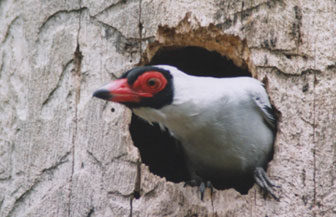Evolution is faster in Canada than in the Amazon argues new study
Evolution is faster in temperate zones
Speciation faster in Canada than in the Amazon argues new study
mongabay.com
March 15, 2007
A new study argues that temperate zones are hotbeds of evolution, not tropical areas as conventionally held.
The research, published in the March 16 issue of the journal Science, says that species do not evolve faster in warmer climates. It suggests that tropical species’ extinction rates are lower than those in temperate regions.
Jason Weir, a zoology PhD candidate at University of British Columbia, and his mentor Professor Dolph Schluter, director of the university’s Biodiversity Research Centre, came to these conclusions after analyzing the DNAs of 618 mammal and bird species that have existed in the Americas during the past several million years.
“It’s been long established that the tropics have more species, but it’s not clear why,” said Weir. “The common assumption is that species simply evolve faster in warmer climates.”
|
|
“Our analysis shows that new species actually evolve faster as we move towards the poles. It would take one species in the tropics three to four million years to evolve into two distinct species, whereas at 60 degrees latitude, it could take as little as one million years.”
Weir says the higher rate of speciation is temperate zones is offset by a higher extinction rate, which he attributes to more intense climate fluctuations.
“In comparison, even though there is a lower speciation rate in the tropics, the stable environment contributes to an equally low extinction rate. As a result, more species survive. This could help explain why there are more species in general in warmer climates,” explained Weir.
“In other words, there’s a higher turnover of species in places like Canada, making it a hotbed of speciation, not the Amazon,” added Schluter.
CITATION: Weir, J.T. and Schluter, D. (2007) “The Latitudinal Gradient in Recent Speciation and Extinction Rates of Birds and Mammals.” Science
Related articles
Evolution is twice as fast in the tropics. Tropical species evolve twice as fast as temperate species according to research published in Tuesday’s Proceedings of the National Academy of Sciences (PNAS). The study, which compared the genetics of 45 common tropical plants with similar species from cooler geographical areas, suggests that evolution takes place at a faster rate in warmer climates either due to higher rates of metabolism, which leads to more genetic mutation, or shorter generations, so genetic changes are rapidly passed on to offspring.
Tropical biodiversity results from age of species argues new theory. Why are there more species in the tropics than in the temperate regions of the globe? Many of the world’s species live in the tropics (perhaps more than half), but the reason has been debated for more than 100 years. Many researchers have hypothesized that climatic factors somehow cause species to originate more quickly in tropical regions. In a paper appearing in the November issue of The American Naturalist, John Wiens and a group of researchers from Stony Brook University have shown that, contrary to expectations, species seem to evolve at similar rates in tropical and temperate regions. What causes the difference in species numbers between tropical and temperate regions is not something special about the tropics that leads to more rapid speciation, but rather that the temperate areas were colonized more recently, leaving less time for species to originate and accumulate in these regions.
This article is based on a news release from the University of British Columbia.
